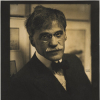Alfred Stieglitz

Alfred Stieglitz
Alfred Stieglitzwas an American photographer and modern art promoter who was instrumental over his fifty-year career in making photography an accepted art form. In addition to his photography, Stieglitz is known for the New York art galleries that he ran in the early part of the 20th century, where he introduced many avant-garde European artists to the U.S. He was married to painter Georgia O'Keeffe...
NationalityAmerican
ProfessionPhotographer
Date of Birth1 January 1864
CountryUnited States of America
Photography is my passion.
I have all but killed myself for Photography. My passion for it is greater than ever. It's forty years that I have fought its fight... I am not fighting to make a 'name' for myself. Maybe you have some feeling for what the fight is for. It's a world's fight... All that's born of spirit seems mad in these days of materialism run riot.
Several people feel I have photographed God. May be.
My ideal is to achieve the ability to produce numberless prints from each negative, prints all significantly alive, yet indistinguishably alike, and to be able to circulate them at a price not higher than that of a popular magazine, or even a daily paper. To gain that ability there has been no choice but to follow the road I have chosen.
Photography as a fad is well-nigh on its last legs, thanks principally to the bicycle craze.
Technically perfect, pictorially rotten. (Stieglitz's standard comment on photographs he rejected for publication in The American Amateur Photographer.)
Standing up here on the hill away from all humans - seeing these Wonders taking place before one's eyes - so silently... watching the silence of Nature. No school - no church - is as good a teacher as the eye understandingly seeing what's before it. I believe this more firmly than ever.
The camera was waiting for me by predestination and I took to it as a musician takes to the piano or a painter to canvas. I found that I was master of the elements, that I could work miracles.
I was sad to leave Europe in 1890, after my student days in Germany... But then, once back in New York, I experienced an intense longing for Europe, for its vital tradition of music, theatre, art, craftsmanship... I felt bewildered and lonely. How was I to use myself?
Snow. White, white, white, soft and clean, and maddening shapes, with the whole world in them.
A work is not art until enough noise has been made about it and someone rich comes along and buys it.
It is not art in the professionalized sense about which I care, but that which is created sacredly, as a result of a deep inner experience, with all of oneself, and that becomes 'art' in time.
We had many books and pictures... my parents' way of life doubtless left a lasting impression on me. They created an atmosphere in which a certain kind of freedom could exist. This may well account for my seeking a related sense of liberty as I grew up.
When I make a picture, I make love.